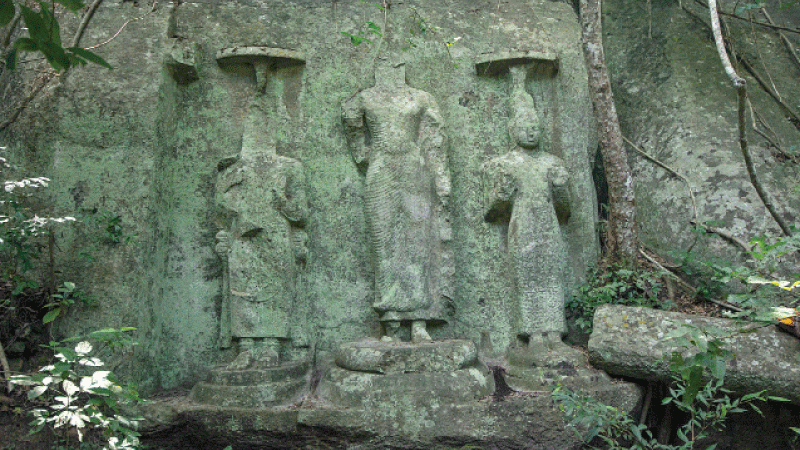
Our destination was a mysterious and deserted place where rock-hewn images of the Buddha and two Bodhisattva Avalokitheswara symbolised Mahayana Buddhism. 
Budupatuna
Budupatuna, in the thick wilderness on the banks of the Wila Oya in the Lahugala-Kumana forest reserve, surrounded by clumps of greenery and jungle, gets no pilgrim or visitor today.
It is silent, save for the sudden winds that take a fancy to howl through the trees. But in its heyday, this was a main spiritual hub and part of the ancient city of Ruhuna.
There is something magical about walking in the jungle early in the morning. The whole place is filled with bird song.
The cries of the changeable hawk-eagle and laughing thrushes filled the morning air as we followed the narrow jungle trail.
A sloth bear paused for us, while a herd of elephants crossed our path.
The landscape kept changing with every turn of the path.
Dense evergreen forests, little muddy pools were with us wherever we walked.
Absolute silence
It was not just the beauty of nature that fascinated us; it was also the absolute silence everywhere.
We walked on the sand dunes, and sometimes waded through the shallow water.
We had not met any ferocious animal during our trek except a lone sloth bear. Elephants, leopards and wild buffaloes had just crossed the river bed as their pug and hoof marks and footprints were sighted on the sand dunes of the river.
Kumbuk Poottuwa
Wila Oya brought us to a great arch of Kumbuk trees (Kumbuk Poottuwa) which was one of the most striking features of our trek. Curving like a Thorana, (arch) two Kumbuk trees grew on either side of the river, stretching over the riverbed to meet above our heads.
Further away from the Kumbuk arch, is another peculiar formation of rock called Goyamkolaya, in the shape of a dagoba in the middle of the river.
It is a landmark and the termination of the trek. A few yards away on the river bank, is a cluster of rocky boulders, where the Budupatuna ancient site is located.
A 1985 discovery
The Budupatuna Mahyanist site was first discovered in 1985 jointly by the Archaeological Department of Sri Lanka and a Japanese expedition team from the Hosei University, who described the statues depicting the Buddha flanked by Bodhisattvas Maitreya and Avalokiteswara.
 The awe-inspiring ancient Mahayanist site, was hewn out of a rocky cliff and three figures carved in relief, on a rock measuring 6 metres in height and 5 metres in width. All three statues stood on pedestals.
The awe-inspiring ancient Mahayanist site, was hewn out of a rocky cliff and three figures carved in relief, on a rock measuring 6 metres in height and 5 metres in width. All three statues stood on pedestals.
The Buddha in the centre was on a lotus pedestal, while the others stood on two layered plinths. These fascinating statues had long been forgotten and left by treasure hunters. When the Japanese team re-visited the site in 1993, they found these statues damaged slightly.
Today, most of it is broken, dug and blasted. Budupatuna has not been fully explored by the Archaeology Department yet, as it is hard to reach the place in the animal infested jungle.
The exhaustion and fatigue experienced during our trek is impossible to express in words.
Having returned to Kotiyagala, ending an eight kilometre trek on foot, we decided to go back one day, as the journey was a great adventure.
